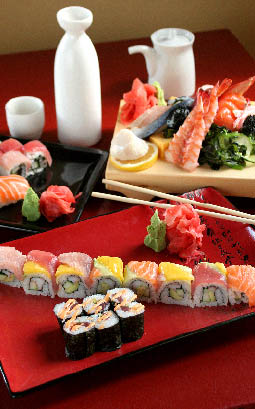For Sake's Sake!
by Bridget Kelly

There’s no avoiding the comparisons. Kibarashi is located in the very same space formerly occupied by the mythical and beloved Kuni’s. And Kibarashi’s owner, Wes, acknowledges the inevitability of comparison. He was a regular at Kuni’s, you see, and it broke his heart when they closed. It’s not possible to replace Kuni’s, any more than it is possible to replace a loved one. “Kuni’s is the golden standard,” Wes says. But, that said, he is overjoyed by his location: Elmwood is his home, and the community has been wonderfully supportive and welcoming of him and of his restaurant since it opened in June.
A native of the New York City area, Wes came to Buffalo partly to get away from the restaurant business, which occupied most of his family. But he knew he would eventually open one. He was starting to look around for a location when Kuni’s closed. Even then, he was not hoping to replace Kuni’s, per se. He has a different idea in mind.
You see, just as Kuni’s was the first to bring sushi to a mainstream audience in Buffalo, Kibarashi hopes to bring a deeper appreciation of sake to Buffalo. Sake is the traditional Japanese rice wine that often accompanies sushi: Served either warmed or chilled, it has a unique and complex flavor and has quite a bite to it. There was a delay in getting a liquor license, as there always is, and so this plan has only just gone into operation. When I came for the review, only a week or so after the license came through, Kibarashi only had one brand of sake, their house brand ($8 for a large tokkuri, which provided about four small cups each). It was tasty, sharp and bright, but unexceptional. Now the restaurant has a whole sake menu posted on its Web site, a dozen different examples of three different types, ranging from $4.50 a serving to $120 a bottle. A re-visit may be in my future, as it should be for any of you who have tried Kibarashi and dismissed it as just another sushi place. You won’t get sake like this anywhere else in this area.
When my guest and I visited it was a beautiful evening on Elmwood, a little early for supper, and we were immediately escorted to a seat at the bar. The bar is low enough that you can watch the chefs work and converse with them, and indeed the head chef Chris Van Every was making conversation with the guests at the bar while he prepared sushi, asking about their experiences with sushi and what they thought of the food here.
For an entrée, my guest chose one of the night’s specials, a blue marlin dish ($16). It was heavenly, although the tender shrimp and exquisite scallops bathed in a delicate, gingery sauce outshone the delicate, understated fish that was meant to be the star. I chose the House Special combination platter ($17 for a half-size portion: I wanted room to try their specialty maki rolls), which started off with a bowl of miso soup—the basic, delicate yet hearty prelude to a good Japanese meal. I savored the soup and watched the chef making up my platter—slicing the sashimi, assembling the maki roll and putting together the eight pieces of nigiri, all beautifully arranged on a dark-red platter inscribed with elegant tategaki Kanji script and sumi-e brushwork.
When the platter was finally placed before me I was not disappointed. The smoked salmon nigiri in particular was divine. The sashimi presentation was tuna and yellowtail atop a vinegary cucumber salad bed, and they were both meltingly tender, their freshness attested to by their subtle flavors.
I still had a little room left, so I asked the chef to make me a maki roll to top us off. He obliged, putting together a roll with some fluke and some tuna and some cucumber and a bit of spicy mayonnaise and wasabi. It was delicious, an example of how Japanese cuisine works by putting flavors next to one another but not quite combining them, so you taste every little thing in turn. He also threw in an unagi (eel) nigiri he’d made, somehow divining that unagi is my secret weakness. It was a supreme effort on my part to courteously offer the unagi to my guest, who knew better than to accept it. (It was delicious.)
If I were going again I would probably nosh my way through more of their specialty maki selection, as I am a sucker for things like the Dynamite Roll ($8.50): cucumber and crab stick with scallop and tobiko, which they then torch burl. I also love nigiri, so if I hadn’t been trying to sample the whole menu for journalistic purposes, I would probably have just asked the chef to keep those coming. But then, they also have several noodle salads, and a decent selection of tempting entrees that don’t have any fish at all in them. I do love me some pork tonkatsue.
We sat, finishing the last of our sake, and the waitress mentioned that they had dessert available. Just for journalistic integrity we had to try the tempura banana split. But I am glad we did—their tempura fryer proved himself exceptional with a banana fried to absolute, crispy, golden perfection, atop a ball of vanilla ice cream, with a rich chocolate sauce drizzled over all. I wasn’t hungry, but it was irresistible, and indeed I’d go back for just that dish—except, of course, that the unagi would never let me out of the place that easily.
And the sake. Oh, the sake. Itadakimasu!
|
Issue Navigation> Issue Index > v5n41: Meet the Governor (10/12/06) > For Sake's Sake! This Week's Issue • Artvoice Daily • Artvoice TV • Events Calendar • Classifieds |









 Current Issue
Current Issue